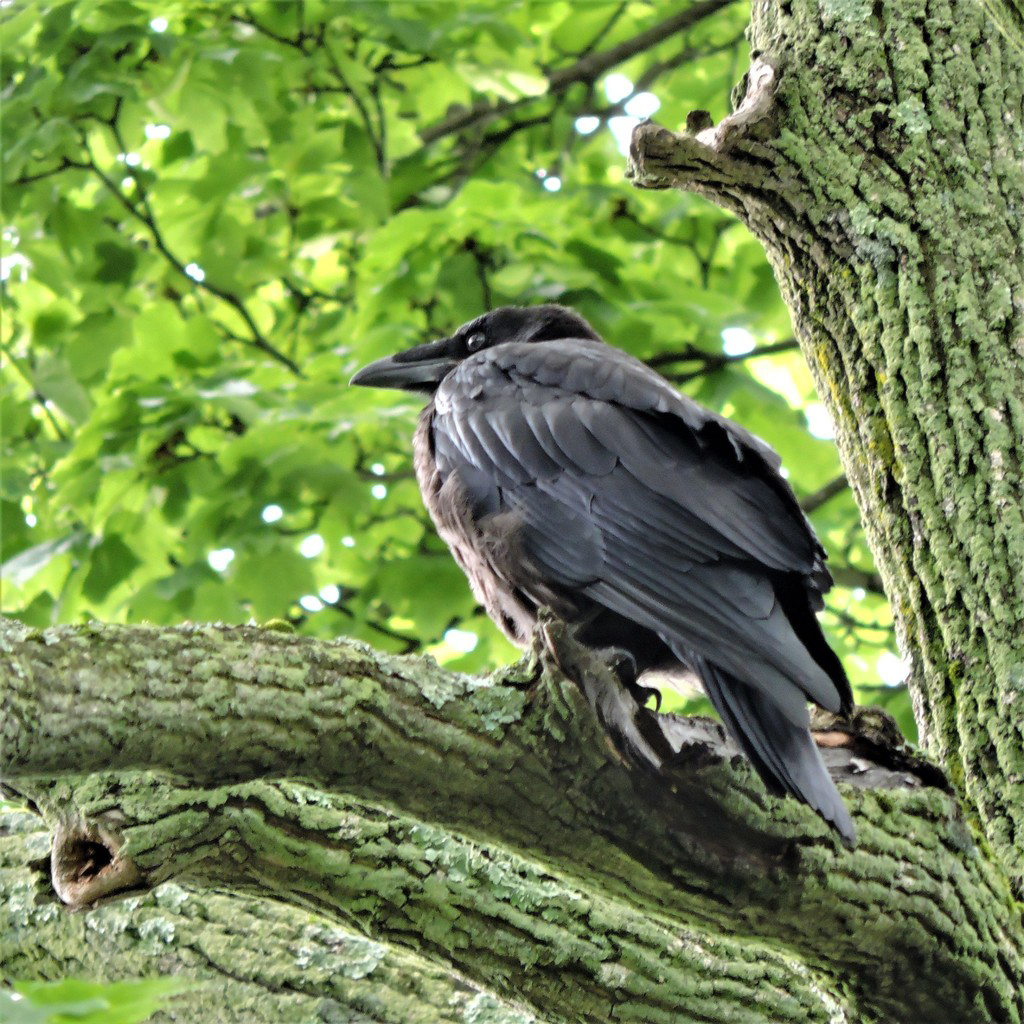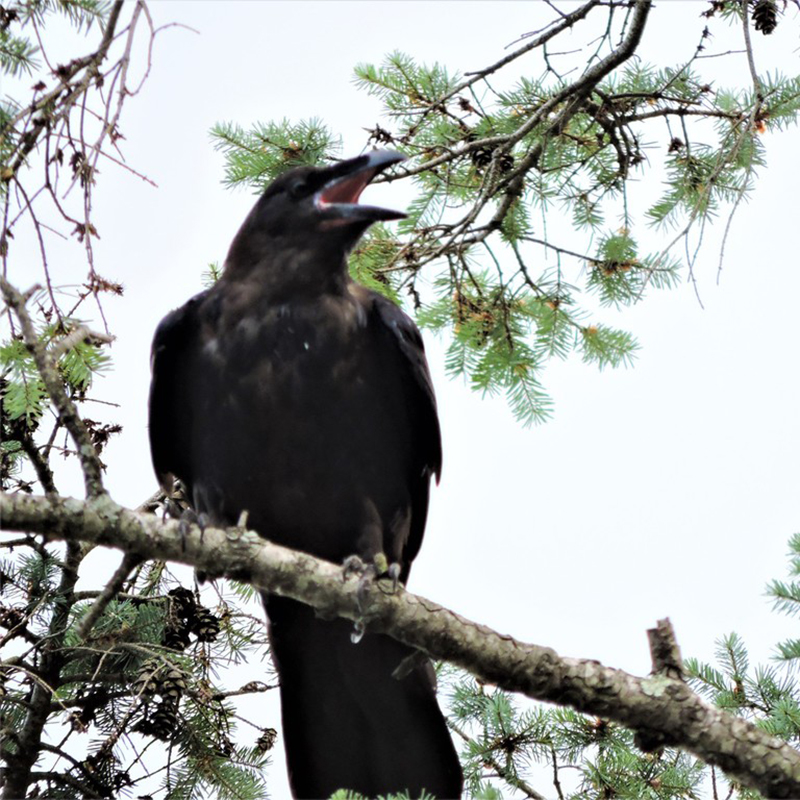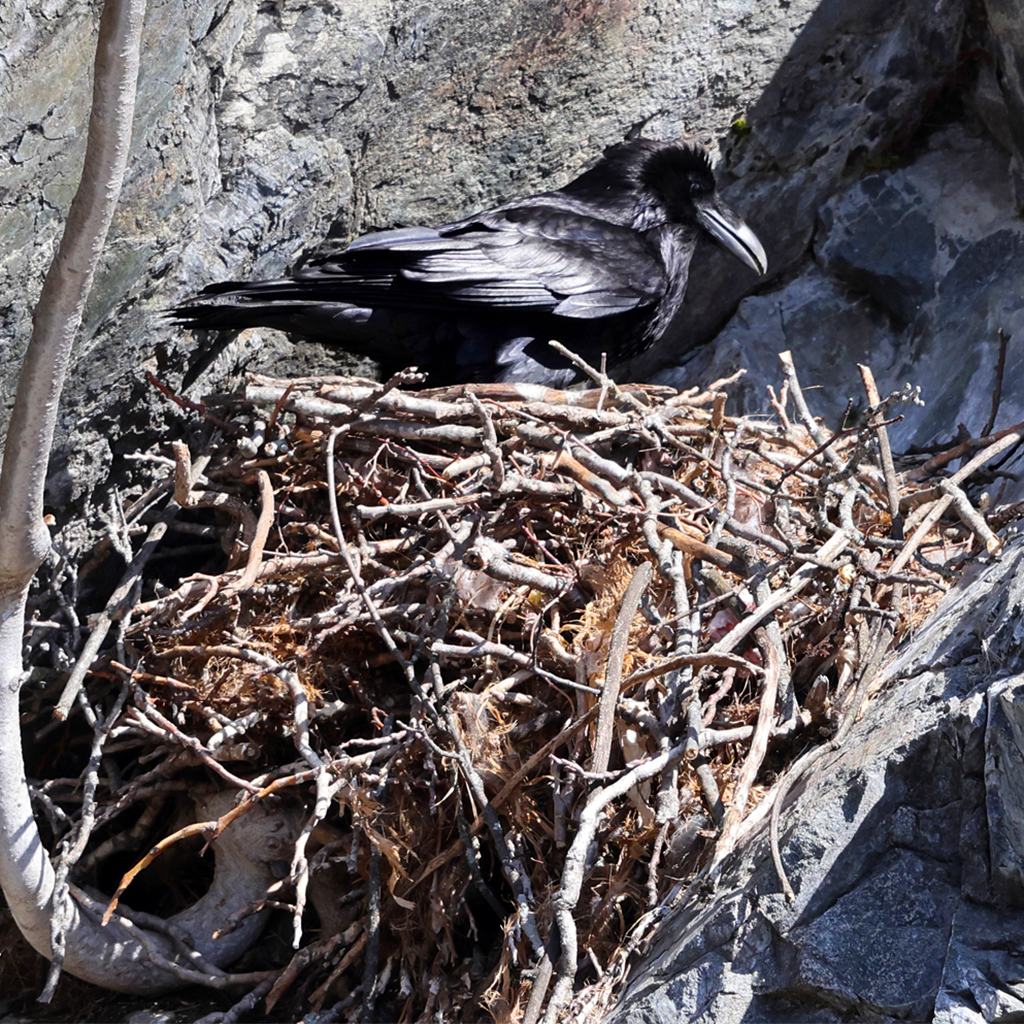Ravens are plotters and alliance-buildings among birds, able to outwit traps and plan

Ravens, like this one in Watertown, are the largest perching birds in the world. (Photo: Ann Schlesinger)
Sometimes when I walk along College Avenue toward Davis Square in Somerville, I hear a GROAK, GROAK behind and above me. I turn around and peer upward at the tallest building around, the Holy Bible Baptist Church. There, atop the steeple, perches a raven staring back at me. The raven is silent as long as I stare at it, but as soon as I turn my back, it GROAKs again. I turn around; it goes silent. This is a little game we play. I have never actually seen the raven call.
Because ravens (Corvus corax) are innovative and adapt to novel situations, they rest atop the avian intelligence ladder. Crows, jays, magpies and parrots are also wicked smart. At the bottom of the avian intelligence ladder are chickens, pigeons and hummingbirds. (Although pigeons, as we know, have phenomenal memories.)

A raven in Watertown makes its signature deep croaking call. (Photo: Ann Schlesinger)
In some ways, it is surprising that ravens are so smart. Like all birds, they are designed for flight, which means they have lightweight bones and small body parts. A raven’s brain is about the size of a walnut. But the neurons in that tiny space are much more densely packed than the neurons in the brains of mammals. (Neurons are the cells responsible for cognition.) Ravens have as many or more neurons as monkeys with their much larger brains. For this reason, a raven’s cognitive ability is comparable to that of a great ape. Some people even refer to ravens as “feathered apes.”

Although ravens weigh up to 3 pounds, much of their body is composed of feathers and designed for flight. (Photo: Tom Murray)
What sets ravens and other corvids apart from birds lower on the intelligence ladder? For one thing, their society is as complex as that of primates. Ravens must be able to understand and respond to the changing needs of others.
Because ravens eat a wide variety of foods, they must adapt continually to novel situations. Their diet varies depending on what food is available, although studies have shown that fledgling survival is highest among those that eat human garbage. Ravens will eat almost anything edible that they can kill or scavenge – from grains to garbage, carrion to caterpillars, eggs to acorns, fish to fruit, buds to berries, road kill to wolf dung. Ravens store surplus food in places they think other ravens won’t find their cache.

A raven nest in Woburn on March 27. (Photo: Tom Murray)
Adult breeding pairs work together to defend territories and raise a family. But they also form alliances with other birds to build support networks. Ravens learn about the personalities of other ravens just like we do – by observations and interactions. The ravens with the greatest number of social bonds sit atop the avian hierarchy, getting the best food and the best nesting locations.
Ravens build bowl-shaped stick nests most often on cliff ledges or in tall trees, but also on telephone poles, billboards or bridges. Breeding pairs defend a territory and the food in it. The female lays three to seven eggs. After the chicks hatch, it takes a month or more for the youngsters to learn to fly. Both parents feed the chicks, who stay with the parents for about six months. At six months, before they are adults, ravens begin to develop social bonds.

Although ravens are three times as large as crows, crows are the aggressor in 97 percent of interactions between the two species. (Photo: Richard George)
In one experiment, scientists tested ravens on 33 social and physical tasks at four, eight, 12 and 16 months of age. The 4-month-old ravens mastered almost all of the tasks, such as understanding numbers or following cues. These young ravens were as accomplished in these tasks as adult chimps or orangutans.
In another study, scientists learned that ravens can plan. Scientists taught eight ravens how to use a stone to open a box containing a substantial amount of food. Other tools did not work. A day later, they offered the ravens a selection of tools and a small treat. The food-containing box was not present. Most of the ravens chose the stone, passing up the treat, even though there was no other food available at the time. Later, the researchers put the box back, and the ravens were able to use the stone to open the box. Planning paid off for those ravens!

A raven attacks a red-tailed hawk in Groton on Jan. 27, 2018. (Photo: Tom Murray)
Ravens do not taste good. According to John James Audubon, “the flesh of this bird is tough and unfit for food.” Despite this, ravens were persecuted heavily in the 1800s because they ate farmers’ grain, and it was said that they also preyed on young lambs. By the 1800s, there were virtually no ravens in Massachusetts. In the 1970s, ravens staged a bit of a comeback and became seasonal visitors. In the 1980s, MassWildlife placed deer carcasses on the ice of the Quabbin Reservoir to aid bald eagle restoration efforts. The carcasses aided ravens, too. Today, ravens live year-round in many parts of the state.

A raven in Spring Hill, Somerville, on Dec. 22, 2020. (Photo: Jennifer Clifford)
In 1833, when John James Audubon wanted to shoot a Canadian raven as it returned to feed her chicks, the raven outsmarted him:
One afternoon I concealed myself under a pile of detached rocks for more than two hours. The young frequently croaked as I was waiting there, but no parent came; so I left the place, but the next moment the female was seen … She alighted in the nest, fed her young, and was off again before I could reach within shooting distance.
Audubon acknowledges how difficult it is to kill a raven: “Indeed, it is extremely difficult to get within shot of an old Raven … They are so cunning and wary, that they can seldom be caught in a trap.”
![]()
Have you taken photos of our urban wild things? Send your images to Cambridge Day, and we may use them as part of a future feature. Include the photographer’s name, date and the general location where the photo was taken as well as any other relevant information.
Jeanine Farley is an educational writer who has lived in the Boston area for more than 30 years. She enjoys taking photos of our urban wild things.



👍👑